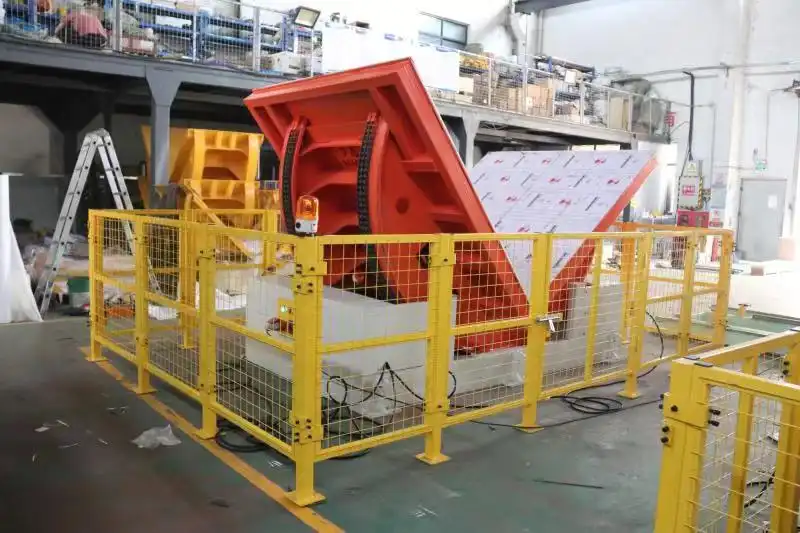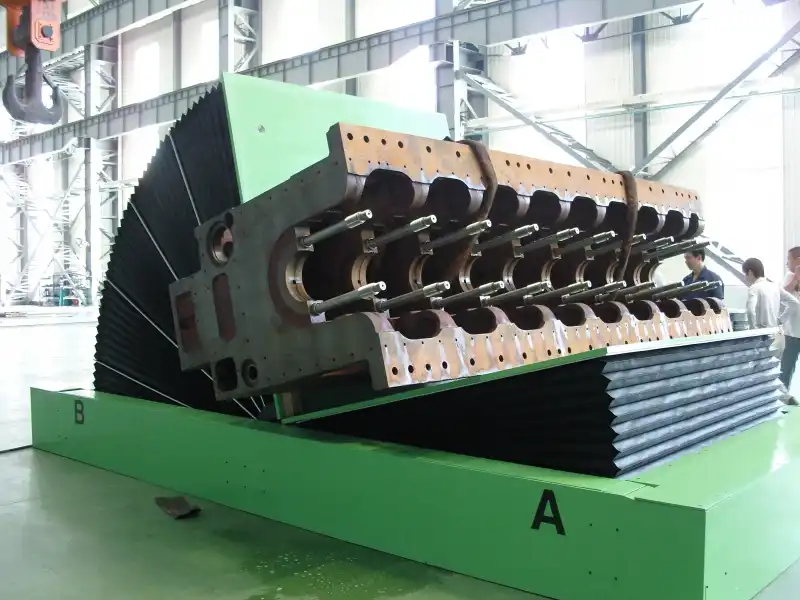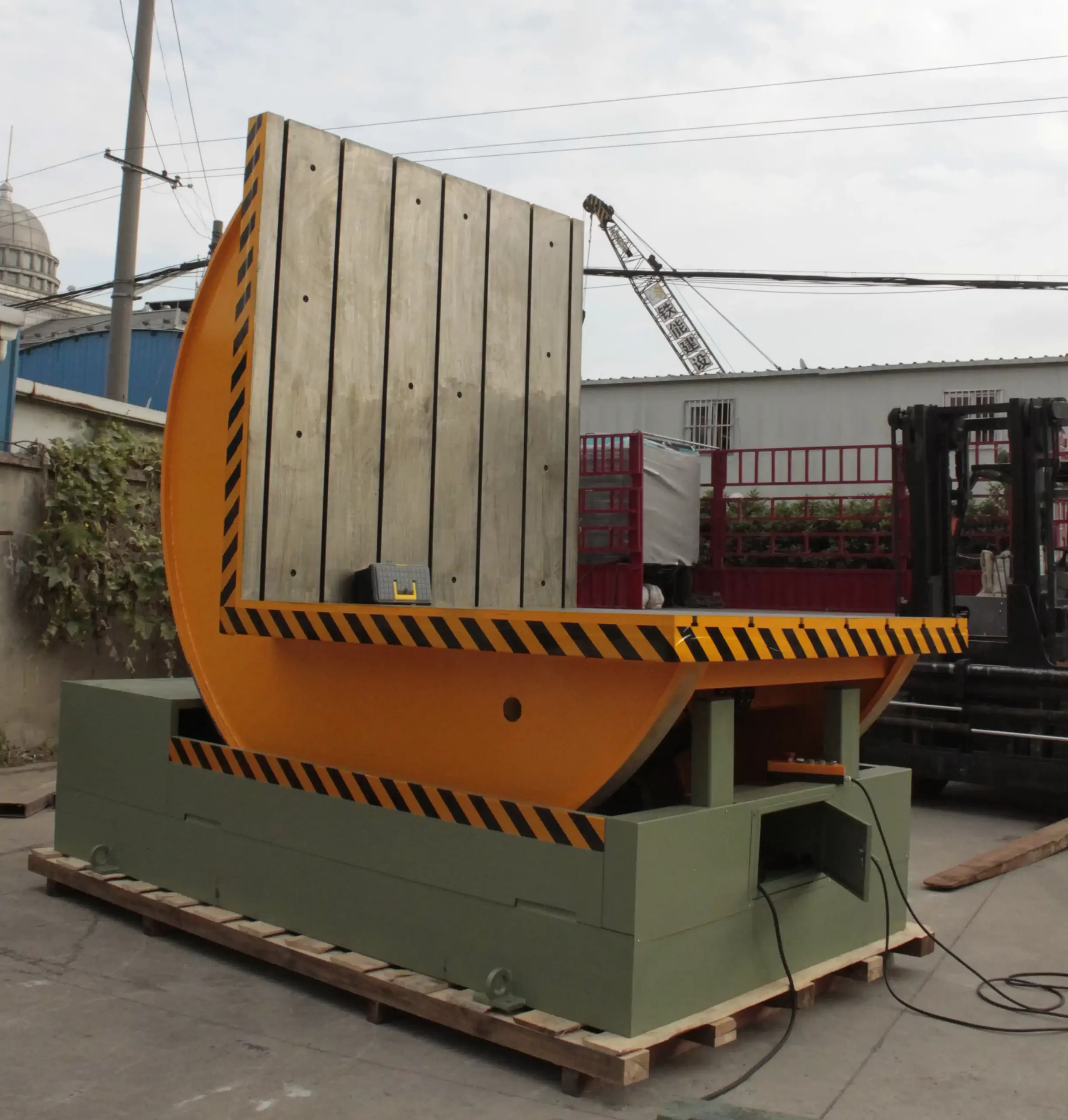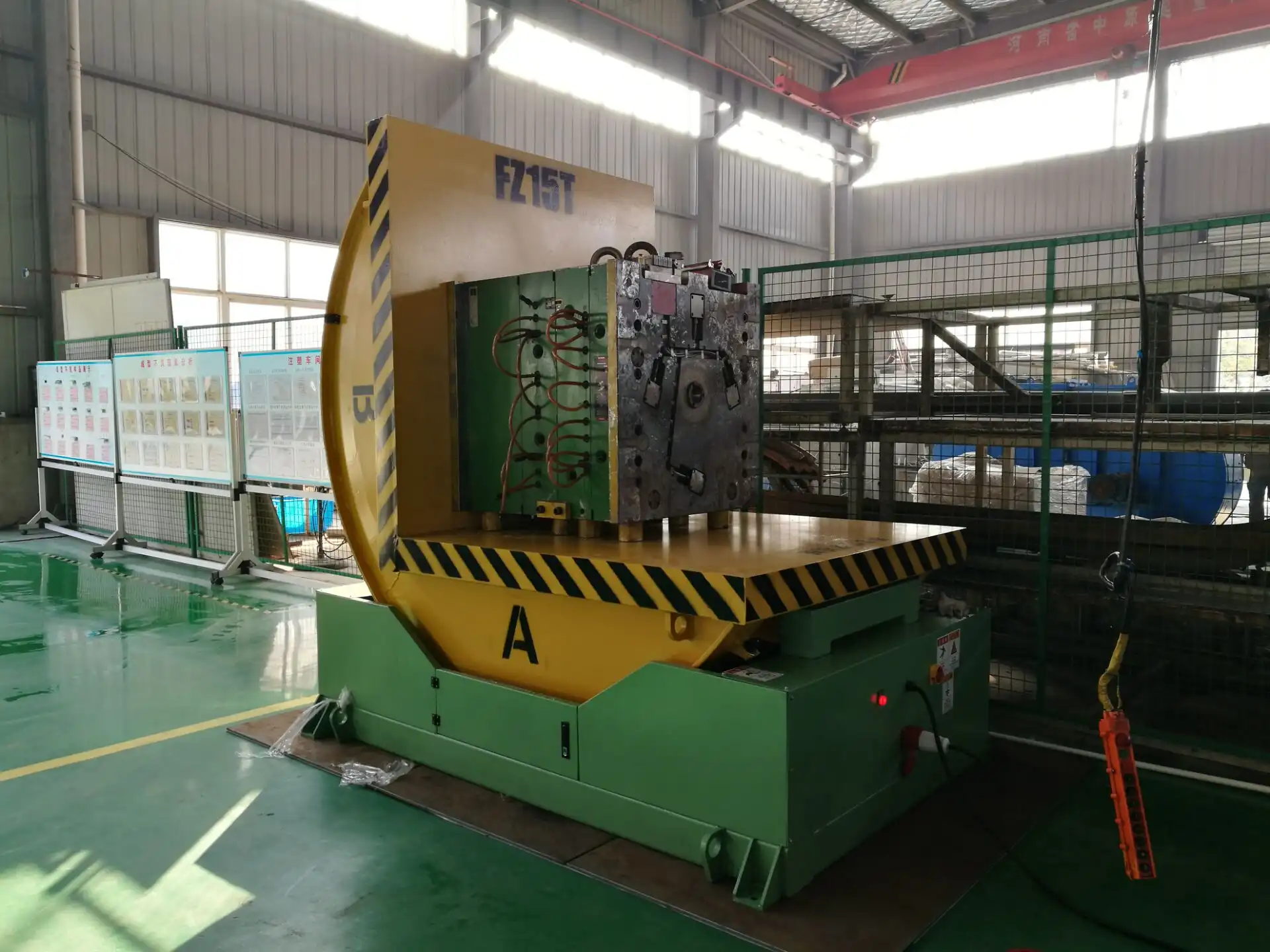Are you still relying on overhead cranes and manpower to turn heavy molds or steel coils? I have seen this method in many factories. It is a slow, risky process. It often creates a major bottleneck in the production line. Each time you flip a heavy load this way, you are taking a gamble. You risk damaging the mold, which can cost thousands to repair. More importantly, you risk the safety of your team. These hidden costs from inefficiency and potential accidents can eat away at your profits. But I want to show you a much better way. I have helped many factories, including some very innovative ones I visited in Brazil, implement a solution that completely transforms this process. It is safer, faster, and much more reliable.
The smartest way to flip molds, which is proving highly effective in modern Brazilian factories, is by using a dedicated 90-degree mechanical or hydraulic mold tilter. This specialized equipment automates the turning process. It drastically improves worker safety, speeds up handling times, and protects your valuable assets from damage. This directly contributes to lower operational costs and higher uptime.

This change is not just about buying a new machine. It is about rethinking a critical step in your entire workflow. Think of it as a strategic investment. This investment pays back through improved safety, increased speed, and real cost savings. It is a foundational step toward a more modern and efficient operation. Let's break down how this works and what you need to consider to make the right choice for your facility.
How Can a 90-Degree Tilter Immediately Improve Safety and Efficiency?
Do you worry about the "close calls" in your workshop when heavy objects are being turned? I know this is a major concern for plant owners. Aging equipment and manual processes make accidents a constant threat. A single incident can lead to terrible consequences. These include serious injuries, damaged equipment, and production halts that disrupt your entire schedule. Relying on luck is not a sustainable business strategy. A dedicated 90-degree tilter removes the human element from the most dangerous part of this task. It provides a stable, controlled, and predictable way to handle heavy loads. This immediately eliminates many common safety risks you face today.
A 90-degree tilter immediately improves safety by securing the load on a stable platform and performing the turn mechanically. This eliminates the need for manual pushing, pulling, or dangerous maneuvers with cranes and chains. Efficiency is boosted because the turning cycle is reduced from many minutes to often less than 60 seconds, creating a smooth and predictable workflow that integrates seamlessly into your production line.

A Tale of Two Methods: Before and After
In my years as an engineer, I have seen the old method countless times. It makes me nervous just watching it. An operator has to attach chains or slings to a heavy mold. The entire area has to be cleared for safety. A crane slowly lifts the load. Then, one or two workers have to manually guide and push the swinging load to get it to turn. The risk of a sling slipping or the load becoming unstable is always present. This process puts immense stress on older cranes and costs a lot in labor time. A single mistake can damage a mold that costs tens of thousands of dollars.
Now, picture the new method with a tilter. A forklift or a crane simply places the mold onto the tilter's platform. The operator steps back to a safe distance and pushes a button on a control panel. The machine performs a smooth, controlled 90-degree turn in under two minutes. There is no manual pushing, no swinging load, and no risk of dropping it. The process is simple, fast, and repeatable every single time. This is the difference between hoping for a safe outcome and guaranteeing one.
Quantifying the Gains in Safety and Efficiency
The impact is not just something you feel; it is something you can measure. For a pragmatic business owner, the numbers matter most. The most obvious gain is in safety. You virtually eliminate the risks of crushed hands or feet, falling loads, and injuries from sling failures. This not only protects your team but also helps you meet increasingly strict government safety regulations.
On the efficiency side, the gains directly impact your bottom line and your goal of higher uptime. A bottleneck at the flipping station can hold up your entire production line. By reducing the cycle time, you create a smoother, faster flow of materials. This helps you get closer to that goal of 95% equipment uptime. Let's look at a direct comparison.
| Metric | Crane & Manual Method | 90-Degree Tilter | Improvement |
|---|---|---|---|
| Cycle Time | 10-15 minutes | < 2 minutes | ~85% Reduction |
| Labor Required | 2-3 Operators | 1 Operator | 50-66% Reduction |
| Risk of Damage | High | Very Low | Significant Cost Savings |
| Safety Incident Risk | Moderate to High | Extremely Low | Improved Worker Morale |
What Are the Key Differences Between Mechanical and Hydraulic Tilters?
You are convinced that you need a tilter. But now you face another question: which type is right for you? The options can seem confusing. You hear terms like "mechanical" and "hydraulic." You need to know which one is the right long-term investment for your steel mill. I have seen clients make this decision without all the facts. Choosing the wrong type can lead to higher maintenance costs down the road. It can also cause unexpected downtime or result in a machine that cannot handle your specific needs. This is a critical decision that will impact your return on investment for many years.
The key difference lies in the power source and the turning mechanism. Mechanical tilters use an electric motor, a gearbox, and heavy-duty chains or screws to rotate the platform. This design offers precision and requires less maintenance. Hydraulic tilters use a pump to push fluid into large cylinders, providing immense power for very heavy loads but requiring more frequent maintenance for hoses, seals, and fluid.

A Closer Look at Mechanical Tilters
From an engineer's perspective, I appreciate the elegant simplicity of a mechanical tilter. The system is straightforward. An electric motor drives a high-torque gearbox. This gearbox then turns large sprockets connected by heavy-duty roller chains, which move the platform. Some designs use large screw jacks instead of chains. Both are reliable and robust.
I recommend mechanical tilters for most applications involving loads up to around 50 tons. They are perfect for environments where cleanliness and precision are important. Because the movement is controlled by a gear system, you can achieve very precise stopping points. This is useful for automated processes. The main benefits are lower maintenance, as there is no hydraulic fluid to leak or replace, and better energy efficiency. The motor only draws significant power during the actual turning cycle. The initial cost can sometimes be higher for mid-range capacities, but the lower operating cost often makes up for it over the life of the machine.
Understanding Hydraulic Tilters
Hydraulic tilters are the heavy lifters of the industry. They operate on a simple principle: immense force generated by pressurized fluid. A hydraulic power unit (HPU), which is an electric motor connected to a pump, pushes hydraulic fluid into large cylinders. These cylinders then push the platform, turning even the most massive loads.
Hydraulics are the best choice when you need to flip extremely heavy objects—I'm talking about loads over 50 or 60 tons. If raw power is your main requirement, hydraulics deliver. They are often less expensive at these very high capacities. However, this power comes with trade-offs. The biggest one is maintenance. Hydraulic systems have hoses, seals, and filters that need regular inspection and replacement. There is always a risk of fluid leaks, which can be an environmental and safety hazard. They are also less energy-efficient, as the HPU often needs to run to keep the system pressurized, and they tend to be noisier.
For a leader focused on ROI and long-term costs, this table should help clarify the decision.
| Feature | Mechanical Tilter | Hydraulic Tilter |
|---|---|---|
| Power Source | Electric Motor, Gears, Chains/Screws | Hydraulic Power Unit (HPU), Cylinders |
| Best For | Precision, Cleanliness, Medium-Heavy Loads | Extreme Power, Very Heavy Loads |
| Maintenance | Low (greasing chains, motor check) | Higher (fluid, filters, hoses, seals) |
| Energy Use | More Efficient (power on demand) | Less Efficient (pump often runs) |
| Leak Risk | None | Moderate (hydraulic fluid) |
| Best Fit For... | Automated Lines, Steel Coils, Molds | Foundries, Extremely Large Castings |
In my experience, for most modern steel coil and mold handling, the mechanical tilter is the more forward-thinking choice. Its precision, lower maintenance, and easier integration fit perfectly with goals for digitalization and predictive maintenance.
How Does a Tilter Fit Into a Fully Automated Production Line?
You are making a smart move by investing in digital transformation. You are implementing systems like MES (Manufacturing Execution System) and using IoT sensors to gather data. But how do you prevent a new piece of handling equipment from becoming an "automation island"? A standalone machine that requires an operator to walk over and push a button breaks the flow of a truly automated line. This small gap in automation can undermine your entire investment and prevent you from reaching that ambitious 95% uptime goal. You need every piece of the puzzle to connect seamlessly.
A tilter fits into a fully automated production line by being equipped with its own PLC (Programmable Logic Controller) and a set of sensors. This "brain" can communicate with your central MES or SCADA system. It can receive automated commands to start a cycle and send signals back confirming the task is complete, all without manual intervention. It becomes just another intelligent node in your production network.

The Communication Backbone: PLC and Sensors
Think of the PLC as the tilter's onboard brain. It is a small industrial computer that controls the machine's functions. But it needs eyes and ears—and that is where sensors come in. We can equip a tilter with various sensors that provide critical data. Photo-eye sensors can detect when a coil or mold has been placed correctly on the platform. Proximity switches or encoders confirm the tilter's exact position—whether it is fully horizontal or fully vertical.
These sensors do more than just run the machine. They provide the raw data points for your big data analysis platform. Every cycle, every position confirmation, every sensor reading can be logged and analyzed. This is how you achieve the complete production visibility you are aiming for. The tilter stops being a "dumb" machine and starts being a smart, data-producing asset.
From Manual Command to Automated Handshake
Let's walk through how this works in a real, automated scenario.
- An AGV (Automated Guided Vehicle) or a conveyor brings a steel coil to the tilter's loading position.
- A sensor on the tilter confirms the coil is present and in the correct spot. It sends a "ready" signal to the MES.
- Your MES, which manages the overall production schedule, checks the workflow and sends a "start cycle" command to the tilter's PLC.
- The PLC executes the command, and the tilter automatically performs the 90-degree turn.
- Position sensors confirm the turn is complete. The PLC then sends a "task complete" signal back to the MES.
- The MES receives this signal and then commands the next process, perhaps instructing an automated crane to pick up the now-vertical coil for packaging.
This entire sequence happens without a single person touching a control button. It is a seamless, digital handshake between machines. This is the key to removing bottlenecks and maximizing your throughput.
The Next Level: Predictive Maintenance Integration
This is where things get really smart and address your challenge with aging equipment. We can integrate more advanced sensors to monitor the tilter's health. We can add sensors to monitor the motor's electrical current, vibration sensors on the main bearings, and a cycle counter in the PLC.
This data is streamed to your central system. Your analytics platform can then identify patterns that predict a future failure. For example, it might flag an alert: "Motor current on the tilter has increased by 15% over the last 50 cycles." This tells your maintenance team to investigate the motor or gearbox before it fails. This is the essence of predictive maintenance. You move from fixing broken machines to preventing them from breaking in the first place. This is fundamental to achieving 95% uptime and lowering your overall operational costs.
What Maintenance Strategies Maximize a Tilter's Lifespan and ROI?
You have made a significant investment in a new, high-quality tilter. But how do you prevent it from becoming just another piece of "aging equipment" in ten years? We have both seen it happen. A robust machine is installed, and it works perfectly. But without a proper care plan, small issues are ignored. Neglecting maintenance, even on the toughest machines, leads to premature wear, surprise breakdowns, and a much shorter operational life. This slowly erodes the very return on investment that you calculated so carefully. A proactive maintenance strategy, combining routine checks with smart data, can ensure your tilter operates like new for decades, protecting your investment and guaranteeing the reliability you need.
The best maintenance strategies to maximize a tilter's lifespan and ROI involve a three-tiered approach. This includes regular operator checks (daily or weekly), scheduled preventive maintenance by trained technicians (monthly or quarterly), and leveraging sensor data for predictive maintenance to address issues before they cause a failure.

Tier 1: Daily Operator Care (The Front Line)
The person who runs the machine every day is your first line of defense. Empowering them with a simple checklist can catch over 80% of potential problems. These are simple, five-minute checks that should be done at the start of every shift.
- Listen: Does the machine sound normal? Any new grinding, whining, or clunking noises?
- Look: Is the area around the machine clean? Is there any debris on the platform or in the mechanism? For hydraulic systems, are there any small drips or puddles of fluid?
- Check: Are all safety guards and emergency stops in place and working? Are the chains on a mechanical tilter visibly lubricated and free of rust?
This simple routine creates a culture of ownership and catches small issues before they become big, expensive problems.
Tier 2: Scheduled Preventive Maintenance (The Playbook)
This is the planned work for your skilled maintenance team. It should be based on the manufacturer's recommendations and your machine's usage rate. A clear schedule ensures that nothing is forgotten. This is where you replace wear parts before they fail and perform deeper inspections.
Sample Preventive Maintenance Schedule
| Frequency | Task (Mechanical Tilter) | Task (Hydraulic Tilter) |
|---|---|---|
| Monthly | Check and adjust chain tension. Lubricate all chains and sprockets. | Check hydraulic fluid level and clarity. Inspect for any minor leaks at fittings. |
| Quarterly | Inspect the gearbox oil level. Check and tighten all major structural bolts. | Inspect all hydraulic hoses for signs of wear, cracking, or abrasion. Check pump pressure. |
| Annually | Test motor performance and electrical connections. Perform a detailed inspection of all welds. | Change hydraulic fluid and filters. Test relief valve settings. |
This structured plan ensures the machine stays within its optimal operating parameters, just like a well-maintained car.
Tier 3: Predictive Maintenance (The Crystal Ball)
This third tier connects back to your digitalization goals. It uses data to make maintenance smarter and more efficient. As we discussed, sensors for vibration, motor current, and temperature provide a continuous health report for your tilter.
Instead of changing a set of bearings every two years as a "just-in-case" measure (a preventive task), a vibration sensor can tell you that a specific bearing is starting to show signs of wear and will likely need replacement in the next 30 days. This approach, known as condition-based or predictive maintenance, has huge benefits. You avoid the cost of replacing parts that are still perfectly good. You also avoid the massive cost of an unexpected failure and the resulting downtime. This data-driven approach is the key to maximizing the lifespan of your equipment and achieving the lowest possible long-term operating cost.
My Personal Take: From Selling Machines to Building Partnerships
When I started my journey in this industry, first as an employee on the factory floor and then as a factory owner myself, I thought success was about building the best possible machine. I was focused on the technical details: the gears, the motors, the strength of the steel. But over the years, especially after seeing so many of my clients grow their own businesses, I learned a crucial lesson. The machine itself is only part of the total solution.
A forward-thinking leader is not just buying a mold tilter. You are buying production stability. You are buying worker safety. You are buying a lower cost per ton of steel produced. You are solving much bigger problems, like volatile energy costs and the unreliability of aging infrastructure. A supplier who only wants to talk about the features of their machine is missing the entire point. They don't understand your world.
This is why our slogan at SHJLPACK is "TOTAL SOLUTION FOR WRAPPING MACHINE." When we worked with those factories in Brazil, we did not just ship a tilter in a box. We asked about their production flow, their automation goals, their control systems, and the skill level of their maintenance teams. We worked with them to make sure the machine was integrated properly. This is what I mean by a strategic partnership. Your suppliers should understand your high-level challenges. They should understand the pressure you are under from fluctuating markets and the need for environmental compliance. The equipment they provide should be a tool that helps you win those larger battles. A machine is a tool. The right partnership is a true competitive advantage.
Conclusion
Adopting a dedicated mold tilter is a strategic move for safety and efficiency. Integrating it correctly transforms your material handling, reduces operational costs, and supports your long-term automation and reliability goals.


